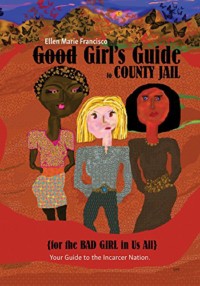Title: Good Girl’s Guide to County Jail
Author: Ellen Marie Francisco
Publisher: FriesenPress
ISBN: 978-1460284773
Pages: 205
Genre: Memoir/ Self-help
Reviewed by: Barbara Scott Bamberger
Pacific Book Review
Arrested after she had a meltdown and tried to steal her own car, Ellen Marie Francisco learned a lot about the legal system from her stint in a California county jail. Her book, Good Girl’s Guide to County Jail serves as both memoir and manual, a guide for others who might ever stand in her shoes and her orange jumpsuit.
Finding she had a penchant for writing and illustrating, Francisco made the most of her time in what she calls the “Incarcer Nation.” She traded her talents for pieces of paper to write and draw on, and for the long litany of plaints and prayers she collected from fellow inmates. The material covered here is a remarkable resource, written, the author states, “to help women everywhere circumvent the entrapment of the system.” Navigating the system is confusing to say the least and her tips and data will be invaluable for anyone in that perilous situation. She presents the Bill of Rights in total, since they deal with individual freedoms, and has gathered statistics supporting her belief that women are still a “minority” when it comes to the legal system. But they do have certain rights when imprisoned, such as requests for health services, library services and receipts for property. She advises “every innie needs an outie” meaning that inmates need someone on the outside looking after their interests, including such crucial matters as money and childcare. Her first piece of advice: when questioned by the police, say nothing.
One of the many chapters in this brightly illustrated guide is a test called “Are You a Bad Girl?” Indicators include having no support system, no fixed address, and lying on welfare applications and tax returns. In “Hindsight Is 20/20” we hear from girls on the inside: “Obey the law and all the rules”; “Never use drugs”; “There are no victims, only volunteers.” In “The Bad Girl’s Glossary of Terms” you will learn that a “kite” is a note passed from one “innie” to another, and “story time” is when that kite is intercepted and gets read out by a deputy over the intercom at bedtime. Francisco found out how to use “contraband Kool-Aid” (stolen from the dining hall) as rouge or hair dye, and make a mirror (there are none in jail) from a foil chip bag. Inmates’ complaints include the need for more toilets, free hygiene items, and outdoor time. In “Hear My Prayer” the author says that prayer in jails is sincere and anguished, making jail a “religious experience” and, “Purgatory is to hell what jail is to prison.”
Reading the information provided by the author along with her memories of her time in “purgatory” and the many sad, mad, strained and misery-laden remarks of other women in the Incarcer Nation will make any sensitive reader feel pity, shock, and a healthy respect for the behaviors that keep most of us on the outside. Many of us, though, have someone, male or female, who is or has been affected by the penal system, or who stands in imminent danger of becoming an “innie.” All should read Good Girls Guide to County Jail. The book, once read, can be donated to an inmate (instructions included) or to your local public or prison library.



Follow Us